J Dent Res Dent Clin Dent Prospects. 19(1):1-8.
doi: 10.34172/joddd.025.41168
Review Article
Spheno-occipital synchondrosis as a reliable indicator of skeletal maturity: A systematic review and meta-analysis
Swati Singh Conceptualization, Data curation, Investigation, Methodology, Resources, Writing – review & editing, 1 
Ravindra Kumar Jain Conceptualization, Investigation, Methodology, Project administration, Supervision, Writing – review & editing, 1, * 
Niha Naveed Validation, Writing – review & editing, 1
Arthi Balasubramaniam Data curation, Investigation, Supervision, Writing – review & editing, 2
Author information:
1Department of Orthodontics, Saveetha Dental College and Hospitals, Saveetha Institute of Medical and Technical Sciences, Chennai, Tamil Nadu, India
2Department of Public Health Dentistry, Saveetha Dental College and Hospitals, Saveetha Institute of Medical and Technical Sciences, Chennai, Tamil India
Abstract
The present review systematically analyzed the available literature on the application of spheno-occipital synchondrosis (SOS) as a skeletal maturity indicator in growing subjects reporting for orthodontic treatment. A systematic search of the available literature on SOS for assessment of skeletal maturity was performed in various databases like Google Scholar, PubMed, and Scopus until December 2023. The risk of bias assessment was performed using the STARD (Standards for the Reporting of Diagnostic Accuracy Studies) statement. A narrative summary on the correlation of SOS with cervical vertebral maturation index (CVMI), hand-wrist maturation (HWM), and chronologic age was done, followed by a meta-analysis with a fixed effects model to quantitatively assess the correlation of SOS with CVMI. A total of eight studies were included in the review, and seven of them reported a significant, strong positive correlation between SOS and CVMI, two studies reported a moderate correlation of SOS with HWM stages, and seven studies reported a good to moderate correlation between SOS and chronologic age. Most included studies had a low risk of bias and were considered good-quality studies. On performing the meta-analysis of both the 4- and 5-stage SOS, a significant positive correlation of SOS with CVMI was noted (P<0.05). The present high-quality evidence suggests a strong positive correlation between SOS and CVMI, a moderate correlation between SOS and HMW, and a moderate correlation between SOS and chronologic age. Hence, SOS can reliably be used as a skeletal maturity indicator.
Keywords: Cervical vertebral maturation, Growth, Hand-wrist radiographs, Maturation, Spheno-occipital synchondrosis
Copyright and License Information
© 2025 The Author(s).
This is an open access article distributed under the terms of the Creative Commons Attribution License (
http://creativecommons.org/licenses/by/4.0/), which permits unrestricted use, distribution, and reproduction in any medium, provided the original work is properly cited.
Funding Statement
Public, private, or non-profit funding organizations did not provide any grants for this research, and it was self-funded.
Introduction
Timing for treatment intervention in orthodontics is very important, especially for growth modulation with functional and orthopedic appliances, as it significantly affects the outcome.1,2 There are various ways to determine the optimal time and assess the patient’s potential for growth. The most conventional and predictable method is hand-wrist maturation (HWM), which entails irradiation exposure. The other widely used skeletal maturity indicator is cervical vertebral maturation (CVM), which is strongly associated with the hand-wrist approach and is regarded as a very reliable technique for evaluating the skeletal maturation of the mandible.3-5
The three synchondroses in the cranial base are significant growth centers, including spheno-ethmiodal synchondrosis, inter-sphenoid synchondrosis, and spheno-occipital synchondrosis (SOS). A cartilaginous connection between the sphenoid body and the basilar portion of the occipital bone is known as SOS. The maxilla is carried upward and forward about the mandible by growth at the SOS, increasing the depth and height of the face. Studies have demonstrated that a protracted orthopedic force on the maxilla induces chondrogenic processes in SOS, and the effectiveness of these appliances is influenced by the fusion stages of SOS. One study concluded that the SOS maturation phases were reliable and accurate markers of skeletal maturity for maxillary growth. Hence, the assessment of SOS staging is important in the planning and execution of orthopedic treatment targeting the maxilla.6-8
Of late, 3D imaging has become widely used in dentistry and orthodontics to diagnose, plan, and assess different treatment modalities and their outcomes. SOS evaluation can only be carried out using CBCTs as they are not easily seen on 2D radiographs.9,10 Studies on the correlation of SOS staging with HWM, CVM, and chronological age have been reported, but no systematic reviews are available. This review was performed to address the question of whether SOS staging is as effective as the other skeletal maturity indicators for determining the pubertal growth spurt.
Methods
Protocol and registration
The PRISMA 2020 statement reporting standards for systematic reviews and meta-analyses were followed in the reporting in this review. This systematic review was registered under the CRD42023448412 registration number and submitted to the PROSPERO database of the International Prospective Register of Systematic Reviews.
Search strategy
Without applying any limitations on publication date or language until December 2023, an electronic search of the literature in the databases listed below—PubMed, Scopus, and Google Scholar—was conducted to find all the articles on the study topic. Table 1 includes the number of search papers in each database and the keywords used. Grey literature was searched using Open Grey and GreyNet International. Rayyan.ai’s duplicate removal tool was used to eliminate duplicates.11
Table 1.
Keywords and databases searched
|
Database
|
Keywords
|
No.
|
| PubMed |
(((((((((((((((spheno occipital synchondrosis maturation) OR (spheno occipital synchondrosis stages)) OR (basi occiput)) OR (basicranial))) AND (growth assessment)) OR (growth prediction)) OR (puberty)) OR (pubertal growth spurt assessment)) AND (correlation)) OR (reliability)) AND (cervical vertebrae maturation)) OR (cervical vertebrae)) OR (cervical maturation assessment)) AND (hand wrist maturation index)) OR (hand wrist radiograph skeletal maturity indicator) |
139 |
| Scopus |
spheno AND occipital AND synchondrosis AND maturation AND growth AND assessment OR growth AND prediction |
64 |
| Google Scholar |
sphenooccipital synchondrosis maturation AND growth assessment AND correlation AND cervical vertebrae maturation stages AND hand wrist radiographs |
211 |
Eligibility criteria
The papers to be included in the review were selected based on the eligibility criteria in PICO format. Studies on human subjects were included in which growth status or pubertal growth spurt of both males and females was assessed using SOS maturation stages or SOS maturation index (3-, 4-, 5-, or 6-stage SOS evaluation), and control comparison was made with other skeletal maturity indicators like CVM stages or HWM stages or dental age assessment and outcomes assessed were correlation or reliability of SOS maturation with other skeletal maturity indicators. Both prospective and retrospective studies were included. Studies on the correlation of SOS maturation only with chronologic age and maxillary and mandibular growth were excluded.
Screening and selection of studies
Authors SS and RKJ screened the titles and abstracts individually, and after mutual consensus, all studies meeting the selection criteria were included in the review. The selection process of included studies is depicted in the PRISMA flow chart (Figure 1). Data required for analysis were extracted independently by both reviewers (SS and RKJ). Study characteristics from the included articles were tabulated and included information about the first author and year of publication, study design, sample size, intervention, control groups, statistics used, outcomes measured, and the individual study conclusions. Any disagreements between the authors (SS and RKJ) regarding data collection were handled by mutual discussion and resolved by consulting a third author (AB).

Figure 1.
Prisma flow chart illustrating the method used to find included studies
.
Prisma flow chart illustrating the method used to find included studies
Risk of bias assessment
Using the tools “Strengthening the Reporting of Observational Studies in Epidemiology” (STROBE) and Standards for the Reporting of Diagnostic Accuracy Studies (STARD), the risk of bias in each study was assessed.12,13 The authors (SS and RKJ) completed the ROB assessment. When the two reviewers could not agree, a third investigator (AB) was contacted in an attempt to achieve a consensus. Each criterion was assigned a point if satisfied and no points if not satisfied. Quality assessment scores ranged from 0 to 12. Articles were classified as “low quality” (score from 0 to 6), “moderate quality” (score from 7 to 10), or “high quality” (score from 11 to 12) (Table 2).
Table 2.
STROBE guidelines for ROB assessment
|
|
|
Yes
|
No
|
| 1 |
Is the objective clearly formulated? |
1 |
0 |
| 2 |
Are there key elements of study design early in the paper? |
1 |
0 |
| 3 |
Was the sample size calculated? |
1 |
0 |
| 4 |
Does the study report the demographic characteristics of the study population? |
1 |
0 |
| 5 |
Were the sample selection criteria clearly described? |
1 |
0 |
| 6 |
Does the study describe the specifications of the material and methods involved including how and when measurements were taken? |
1 |
0 |
| 7 |
Was there a reliability assessment, with an adequate level of agreement intraexaminer or/and interexaminer? |
1 |
0 |
| 8 |
Were measurements undertaken blindly? |
1 |
0 |
| 9 |
Does the study give details of methods of assessment (measurements) for each variable of interest? |
1 |
0 |
| 10 |
Was there a complete and adequate reporting of results, with self-explanatory tables and figures? |
1 |
0 |
| 11 |
Was there a statistical analysis appropriate for data? |
1 |
0 |
| 12 |
Was the P value stated or confidence intervals provided? |
1 |
0 |
Synthesis measures
The studies included in this review employed different methods of SOS staging in different populations. A fixed-effects meta-analysis was performed to assess the correlation of 4-stage SOS and 5-stage SOS with cervical vertebral maturation index (CVMI). A qualitative summary of the correlation of SOS with CVMI, HWM, and chronologic age was performed, illustrating the results of individual studies based on the groups evaluated.
Outcome measures
The outcome measures of this review included the correlation between SOS maturation stages and other skeletal maturity indicators like CVMI and HWR, as well as the intra- and inter-rater correlation for SOS staging.
Results
Study selection based on PRISMA flowchart
The initial search of all databases yielded 414 studies, and after removing duplicates manually, the remaining 288 studies were subjected to title screening. A total of 256 papers were excluded, and 32 studies were subjected to abstract screening for the eligibility criteria. Finally, eight studies14,15,16-21 were included for qualitative analysis and four for quantitative synthesis.15,18,19,21
ROB assessment
Except for the study by Alhazmi et al,17 which was of moderate quality, all the included studies were of high quality. Sample size calculation was not reported in 6 studies.14-18 Outcome measurement blinding was not reported by Alhazmi et al (Table 3).
Table 3.
ROB assessment of the included studies based on STROBE and STARD guidelines
ROB
criteria
|
DemirturkKocasarac et al15
|
Halpern14
|
Fernández-Pérez et al21
|
Fayad et al19
|
Dillon16
|
Alhazmi17
|
Fu20
|
Kim et al18
|
| 1 |
1 |
1 |
1 |
1 |
1 |
1 |
1 |
1 |
| 2 |
1 |
1 |
1 |
1 |
1 |
1 |
1 |
1 |
| 3 |
0 |
0 |
1 |
0 |
0 |
0 |
1 |
0 |
| 4 |
1 |
1 |
1 |
1 |
1 |
1 |
1 |
1 |
| 5 |
1 |
1 |
1 |
1 |
1 |
1 |
1 |
1 |
| 6 |
1 |
1 |
1 |
1 |
1 |
1 |
1 |
1 |
| 7 |
1 |
1 |
1 |
1 |
1 |
1 |
1 |
1 |
| 8 |
1 |
1 |
1 |
1 |
1 |
0 |
1 |
1 |
| 9 |
1 |
1 |
1 |
1 |
1 |
1 |
1 |
1 |
| 10 |
1 |
1 |
1 |
1 |
1 |
1 |
1 |
1 |
| 11 |
1 |
1 |
1 |
1 |
1 |
1 |
1 |
1 |
| 12 |
1 |
1 |
1 |
1 |
1 |
1 |
1 |
1 |
Qualitative assessment of the included studies
Out of the eight studies included in the review, seven were high-quality studies14,15,16,18-21 and reported on the correlation between SOS and CVMI, with two studies reporting on the correlation between SOS and hand-wrist assessment.16,19 The correlation between dental age and SOS was reported in two studies.14,15 All the studies reported using correlation tests and the intra- and inter-rater reliability. The age range of the included subjects was 6‒30 years. Different methods of SOS staging were used in the studies included, and all the included studies employed CBCT for imaging the SOS. The five-stage SOS scoring method by Bassed et al22 was used in three studies.20,21 The four-stage SOS method by Franklin and Flavel23 was employed in two studies.15,19 The three-stage SOS scoring method was used in two studies.14,17 (Tables 4 and 5)
Table 4.
Study characteristics
|
Author, Year
|
Study sample
|
Intervention
|
Comparator
|
SOS reliability
|
SOS correlation stats
|
| Halpern, 2014, retrospective study14 |
CBCTs of 77 subjects (42 F & 35 M, age 9-21 years) divided into 6 groups |
SOS maturation three-stage index by Melsen (1972) |
1. CVM index by Baccetti
2. DI
3. Chronologic age |
Cohen kappa |
Spearman correlation |
| Demirturk Kocasarac et al, 2016, retrospective study15 |
Panoramic radiographs, lateral cephalometric radiographs and CBCT scan 116 subjects (43 M and 73 F, age 8-18 years) |
Assessment of SOS maturation using the four-stage system by Franklin and Flavel24 |
1. CVM assessment by Hassel and Farman
2. Dental age estimation with third molar maturation (TMM)
3. Chronologic age |
Kappa stats for intraobserver |
Spearman
correlation |
| Fernández-Pérez et al, 2016, retrospective study21 |
CBCTs of a 315 participants (167 M and 148 F,
age 6-23 years) |
Assessment of SOS maturation using the 5 stage system by Bassed et al23 |
CVM index by Baccetti |
Cohen kappa stats for intra and inter-rater agreement |
Spearman non-parametric tests |
| Dillon, 2018, retrospective study16 |
CBCT and HW radiograph taken within three months of each other. 61 patients, 33 F and 28 M,
Age 9.5-17.5 years |
Analysis of SOS maturation by Kinder's five-stage method (2009) |
1. CVM index by Baccetti.
2. HWM by Hagg and Taranger |
kappa statistics and Kendall’s coefficient of concordance |
Spearman correlation |
| Fu, 2018, retrospective study20 |
CBCT scans of 275 patients aged 6 to 30 years |
Assessment of SOS maturation using a 5 stage system by Bassed et al23 |
1. CVM index by Baccetti. |
Cohen kappa |
Spearman correlation
P value < 0.05 |
| Fayad et al, 2020, retrospective study19 |
CBCT scans and lateral cephalograms of 117 patients (55 M and 62 F,
age 8-18 years) |
Assessment of SOS maturation by the 4 stage method of Franklin and Flavel24 |
1. CVM index by Baccetti
2. Measurements of ANB and GoGn-SN angles |
Cohen’s Kappa observer reliability |
Spearman correlation
Fisher exact test |
| Alhazmi et al, 2021, retrospective study17 |
CBCT scan and HW radiographs of 164 subjects (77 M and 87 F,
age 10-18 years) |
Assessment of SOS maturation using a modified three-stage system |
HWM index by Fishman |
Cohen’s kappa observer reliability tests |
Kendall rank correlation fisher exact tests for association of HWM and SOS stages |
| Kim et al, 202318 |
CT images of 630 Korean subjects in the age range of 6-18 years |
5 stage SOS scoring system |
1. CVM index by Baccetti
2. Chronologic age |
Kappa coefficient |
Spearman’s correlation analysis |
DI: development of the mandibular canine; CBCT: cone-beam computed tomography; CVM: cervical vertebrae maturation; SOS: spheno-occipital synchondrosis; CT: computed tomography; HWM: hand-wrist maturation: M: males; F: females
Table 5.
Results of the included studies
|
Author, Year
|
Results
|
Inference
|
| Halpern, 2014, retrospective study 14 |
SOS maturation showed a significant correlation with both chronologic age (0.830 F and 0.849 M and CVM (0.831 F and 0.870 M (P ≤ 0.001). A weak correlation (P ≤ 0.001) was discovered between SOS maturation and DI (0.734 F and 0.638 M). |
CVM corresponds with SOS stages. |
| Demirturk Kocasarac et al, 2016, retrospective study15 |
For both genders, there is a strong correlation (r = 0.810) between age and SOS fusion (r = 0.643). TMM and SOS were shown to have strong (r = 0.759) and moderate (r = 0.534) correlations for males, respectively. CVM and SOS fusion showed positive and good (r = .851) and strong (r = 0.618) correlations for females. |
In the young Turkish population, a good correlation between the degrees of TMM, fusion of SOS, and CVM. |
| Fernández-Pérez et al, 2016 retrospective study21 |
Age and SOS had a strong correlation (r = 0.66). Additionally, sex and SOS had a weak but significant correlation (r = 0.15). Strong and substantial correlations were found between vertebrae and SOS (r = 0.89), age and synchondrosis (r = 0.73, and r = 0.65, for females and males respectively, P < 0.001), and both for females and males. |
From the SOS stage, the CVM stage may be accurately predicted. The SOS stages are a reliable indicator of maturation of growth. |
| Dillon, 2018, retrospective study16 |
Average intra and inter-rater reliability was noted for SOS (intra-rater ĸ = 0.642; inter-rater ĸ = 0.886). A moderate correlation between CVMI and SOS (r = 0.68, spearman correlation), and the kappa coefficient - 0.25, which indicates fair agreement. HWM vs SOS correlation was moderate (r = 0.73)
The SMIs that agreed most closely were the HWM and SOS (ĸ = 0.5079). Chronologic age was not well correlated with SOS. |
SOS stages had least intra and inter-rater agreement. SOS closure was not well correlated with age and had the highest agreement with HWM. |
| Fu, 2018, retrospective study20 |
A strong positive correlation between the CVM and SOS closure (rs= 0.908) and between SOS stages and age was noted (rs- 0.857) |
The maturation stage of SOS is a potential indicator for skeletal maturity assessment |
| Fayad et al, 2020, retrospective study 19 |
SOS maturation and CVM were shown to be strongly correlated (r = 0.852, P < 0.001 spearman correlation, females - 0.86, males - 0.83). Only in the CVM stage 2 group and in the CVM stage 4 group did gender and SOS significantly correlate, according to Fisher's exact test. For the SOS index, Cohen's kappa analysis revealed nearly perfect intra-rater reliability (k = 0.85, P < 0.001) and strong inter-rater reliability (k = 0.80, P< 0.001).
Strong correlations were seen between chronological age and SOS fusion (r = 0.705, P < .001), with males showing higher correlations (r = 0.819, P< 0.001) than females (r = 0.794, P < 0.001). |
CVM and SOS fusion have good correlation. Compared to males, girls have an earlier fusion of SOS to their CVM, and the vertical growth pattern may have an impact on the association between SOS and CVM stages. |
| Alhazmi et al, 2021, retrospective study 17 |
For both genders, a strong positive correlation between HWM maturity and SOS fusion stages was found. In both males and females, Kendall's rank correlation between HWM and SOS was high and positive (r = 0.74 and r = 0.71, respectively). |
A biological marker for mandibular and craniofacial growth spurt prediction is SOS fusion. |
| Kim et al, 2023 18 |
In both males and females, there was a significant correlation (P < 0.001) between age and the SOS fusion stage (rs = 0.887, rs = 0.885) and between the CVMI stage and the SOS fusion stage (rs = 0.955, rs = 0.964). |
Basic references for the CVMI stage and the SOS fusion stage from preadolescents to young adults in the Korean population has been provided. |
DI: development of the mandibular canine; CBCT: cone-beam computed tomography; CVM: cervical vertebrae maturation; SOS: spheno-occipital synchondrosis; CT: computed tomography; HWM: hand-wrist maturation; M: males; F: females
Association of SOS with CVMI
Seven studies evaluating the correlation between SOS and CVMI reported a significant positive correlation (P < 0.001) in both genders and used either Spearman’s or Pearson’s correlation. Six out of the seven studies reported a strong correlation,14,15,18-21 whereas one study16 reported a moderate correlation in both males and females. All the studies found that the beginning of SOS closure coincided with the onset of PHV, and a complete closure of SOS indicated the completion of the pubertal growth spurt.
Quantitative assessment of 4-stage SOS with CVM
Meta-analysis of the correlation between the 4-stage SOS and CVM showed that each included study showed a significant strong positive correlation in males (r = 0.844) (P < 0.001) (Figure 2, Table S1), and no heterogeneity was reported (I2 = 0%). A moderate positive correlation (r = 0.761) (P < 0.001) with high heterogeneity (I2 = 91.41%) was noted in females (Figure 3, Table S2). A moderate positive correlation (r = 0.775) (P < 0.001), with a moderate heterogeneity (I2 = 49.9%) (Figure 4, Table S3), was noted when gender was not considered.
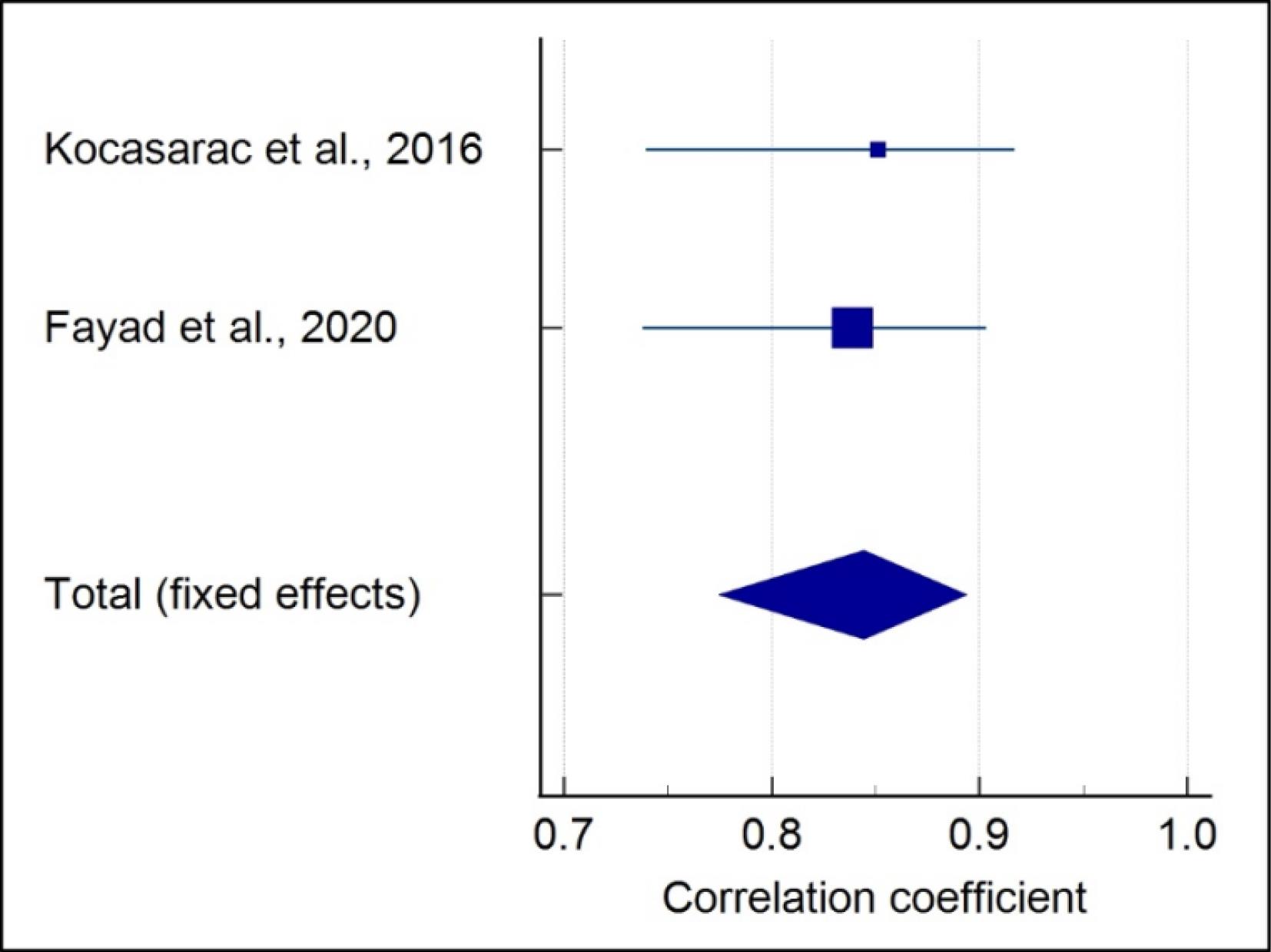
Figure 2.
Forest plot of correlation between 4 stage SOS and CVMI in males
.
Forest plot of correlation between 4 stage SOS and CVMI in males
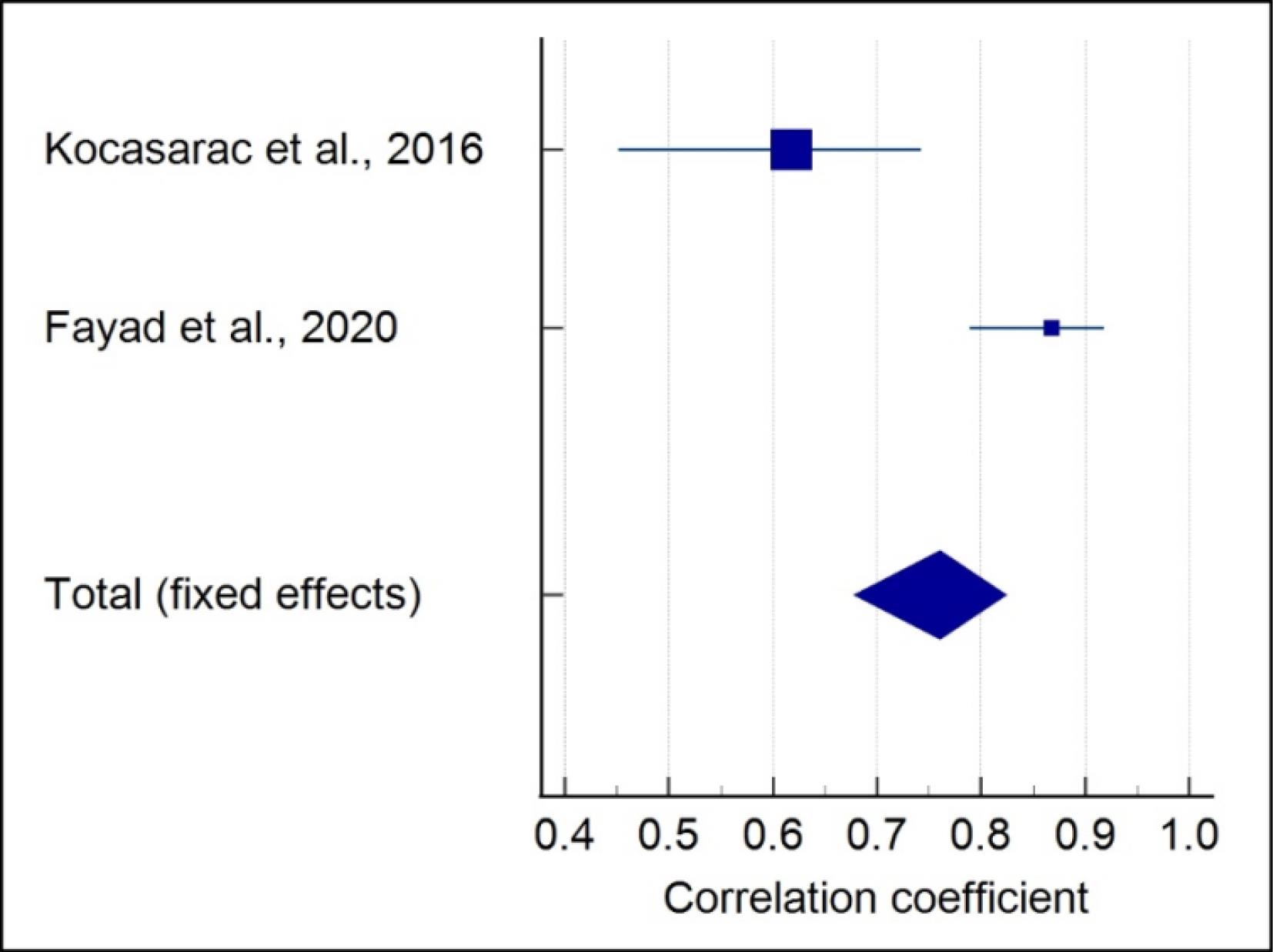
Figure 3.
Forest plot of correlation between 4-stage SOS and CVMI in females
.
Forest plot of correlation between 4-stage SOS and CVMI in females
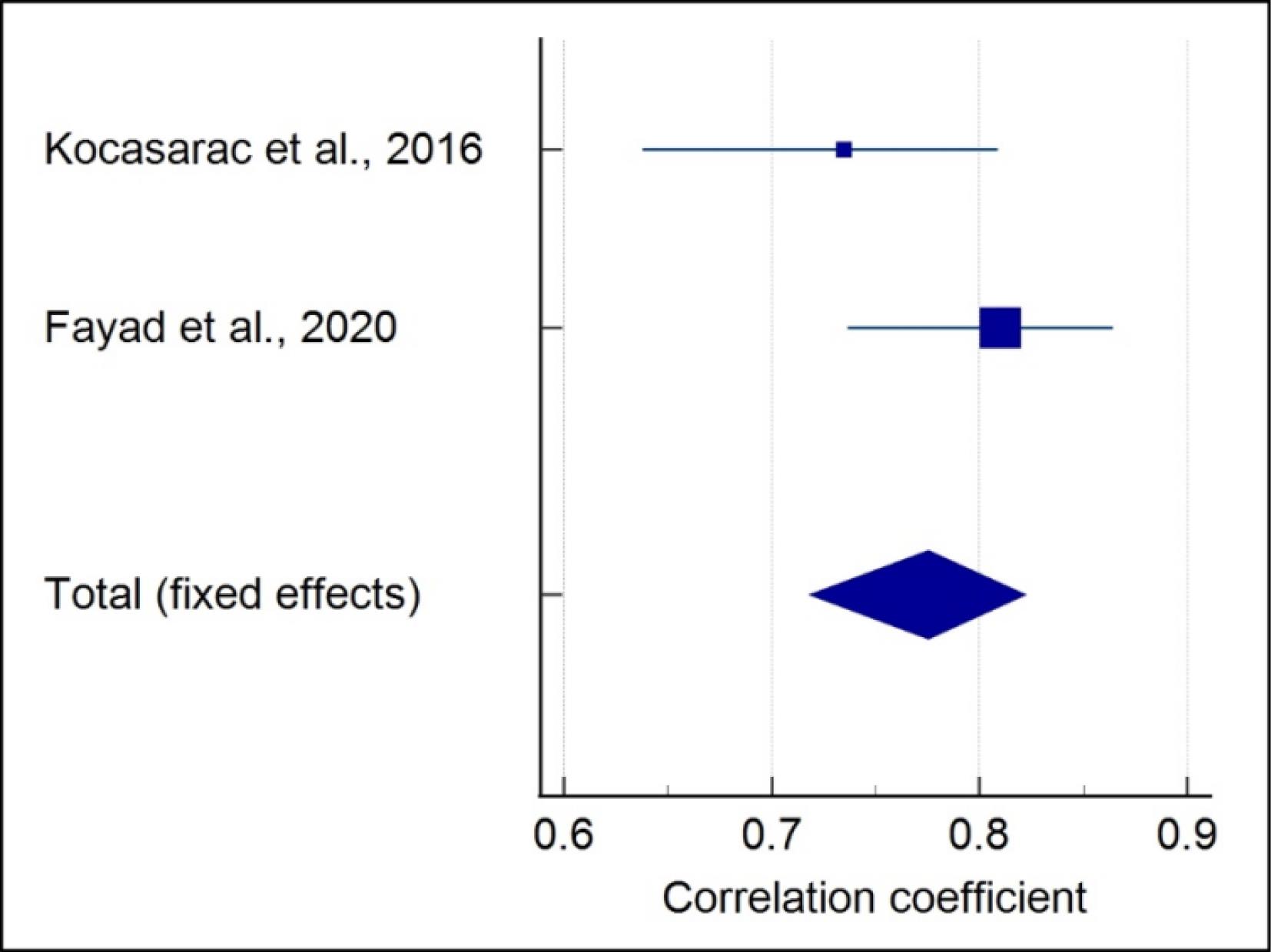
Figure 4.
Forest plot of correlation between 4 stages SOS and CVMI for no gender discrimination
.
Forest plot of correlation between 4 stages SOS and CVMI for no gender discrimination
Quantitative assessment of 5-stage SOS with CVM
Meta-analysis of the correlation between the 5-stage SOS and CVM stages showed that each included study showed a significantly strong positive correlation in males (r = 0.938) (P < 0.001) (Figure 5, Table S4), and a high heterogeneity was reported (I2 = 95.64%). A strong positive correlation in females (r = 0.947) (P < 0.001) with high heterogeneity (I2 = 97.42%) was noted (Figure 6, Table S5). A strong positive correlation (r = 0.944) (P < 0.001), with high heterogeneity (I2 = 98.25%) (Figure 7, Table S6) was noted when gender was not considered.
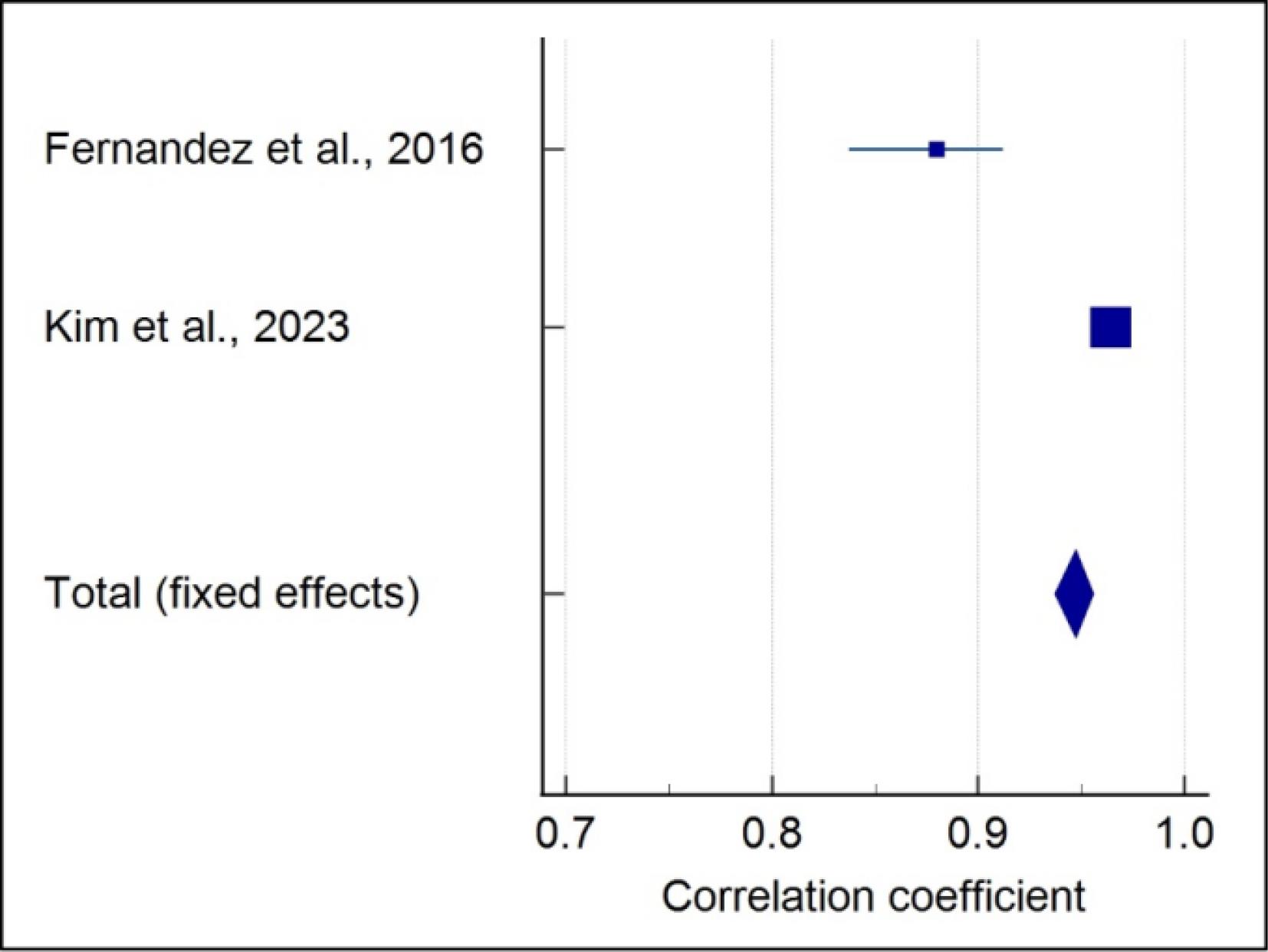
Figure 5.
Forest plot showing the meta-analysis correlation coefficient results for CVM and SOS in female gender (5 stage)
.
Forest plot showing the meta-analysis correlation coefficient results for CVM and SOS in female gender (5 stage)
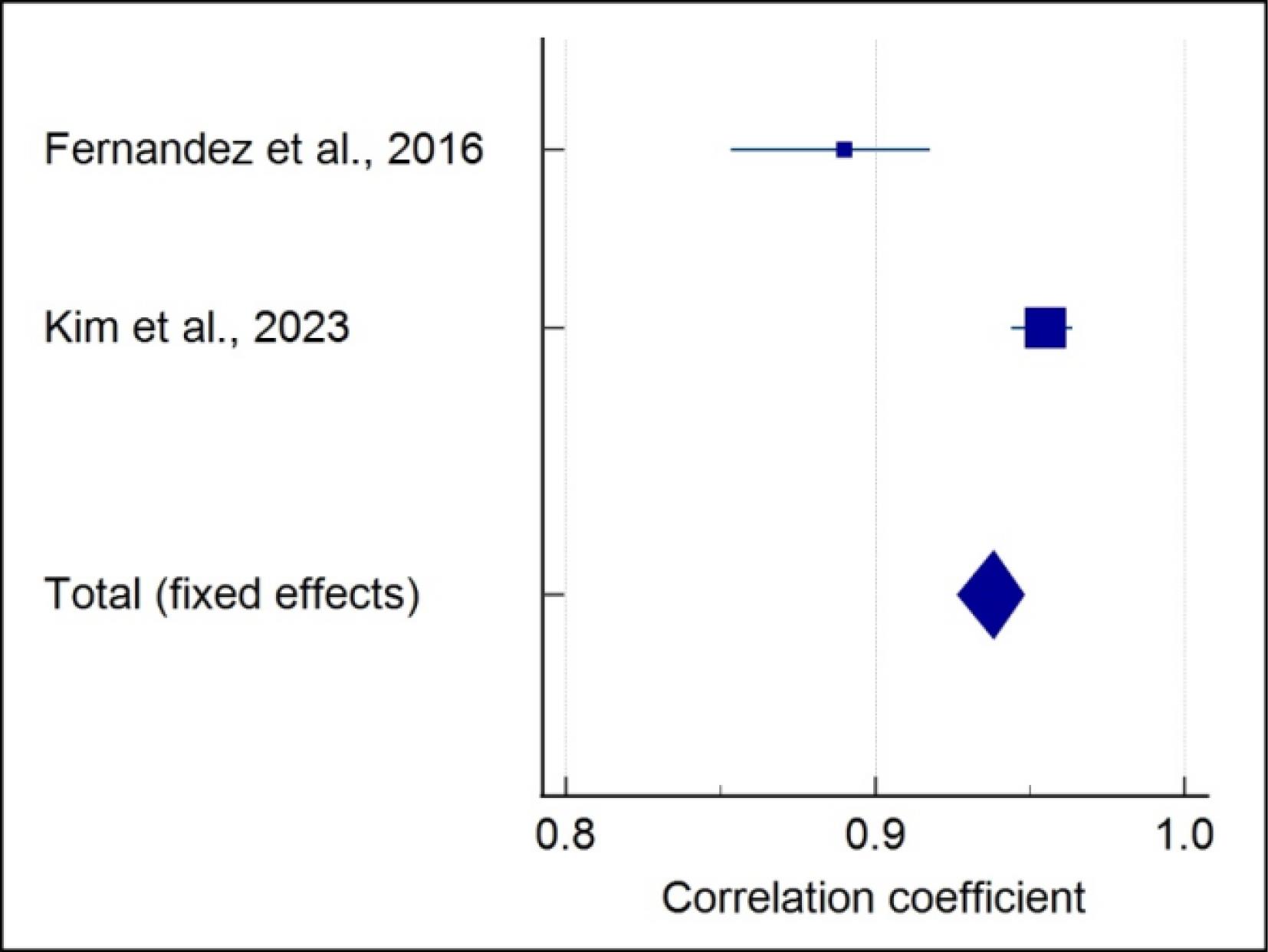
Figure 6.
Forest plot showing the meta-analysis correlation coefficient results for CVM and SOS in male gender (5 stage)
.
Forest plot showing the meta-analysis correlation coefficient results for CVM and SOS in male gender (5 stage)
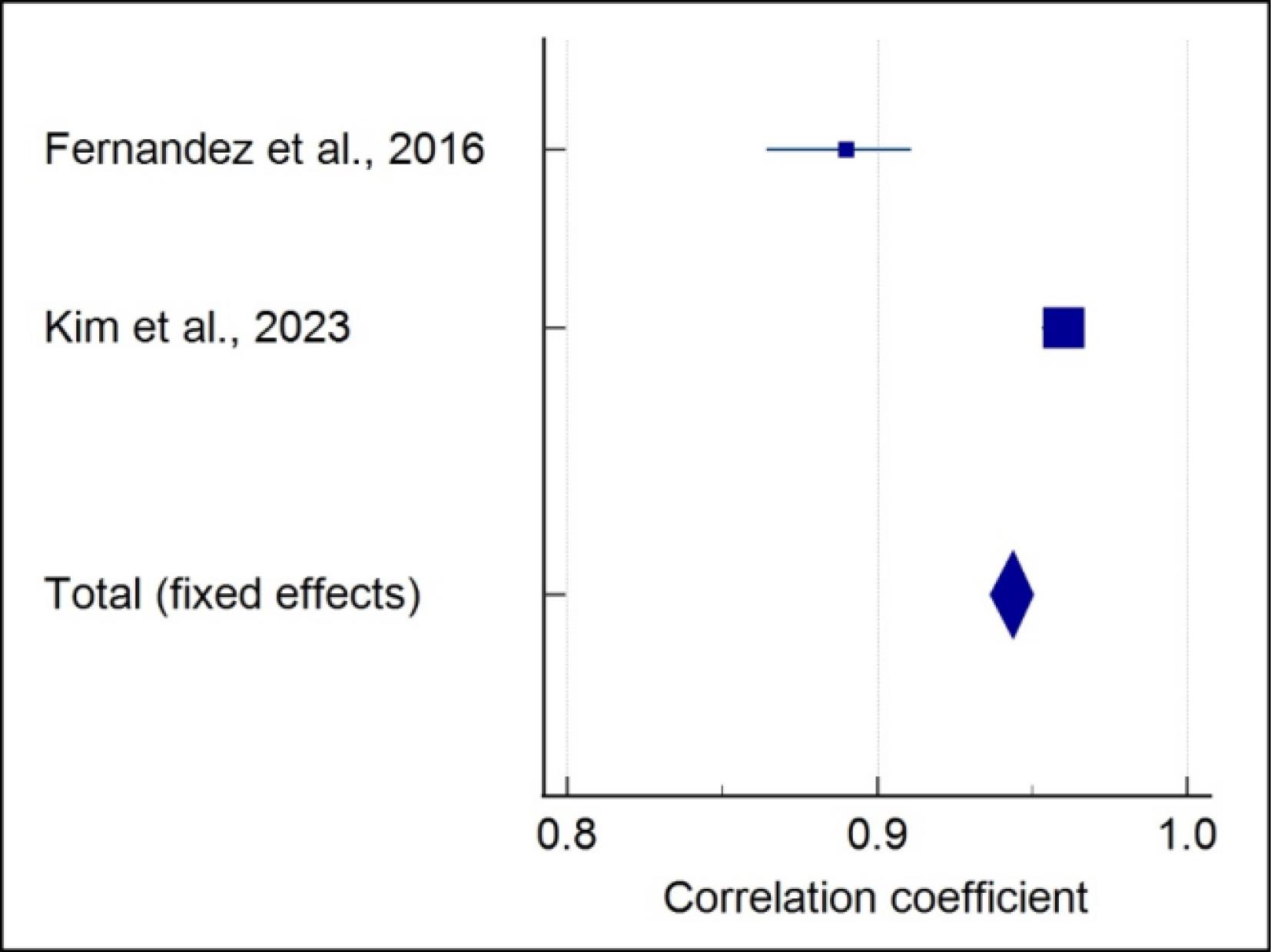
Figure 7.
Forest plot showing the meta-analysis correlation coefficient results for CVM and SOS with no gender discrimination (5 stage)
.
Forest plot showing the meta-analysis correlation coefficient results for CVM and SOS with no gender discrimination (5 stage)
SOS association with HWM
Correlation between HWM and SOS fusion percentage was significant and moderate to good in both males and females, as noted in both studies.16,17 Meta-analysis could not be conducted as both included studies employed different methods for SOS and HWM staging.
Association with dental development
A weak correlation was found between SOS maturation and dental development (DI), as reported by Halpern,14 and a moderate association in females and a strong correlation in males was noted by Demirturk Kocasarac et al.15
Correlation with chronologic age
Except for the study by Alhazmi et al,17 all the studies reported the correlation of chronologic age with SOS maturation. One study concluded that SOS closure was not well correlated with age. The other six studies concluded that chronologic age was significantly correlated with SOS.14,15,18-21 In general, males had higher correlation values than females.
Reliability
Excellent reliability of the SOS index for both inter- and intra-rater was noted in seven studies14,15,17-21 and moderate in one study.16
Discussion
Description of the included studies
The eight included studies were retrospectively performed. They evaluated the potential of SOS as a skeletal maturity indicator. The synthesis of the findings from the included studies provides a fair understanding of the potential use of SOS as a skeletal maturity indicator, its reliability, and the clinical implications of SOS assessment. The studies evaluated different populations and used various methods of SOS assessment. SOS staging correlated well with both CVMI staging and moderately with the HW method of skeletal maturity assessment, irrespective of the method of SOS staging employed, and all the included studies were of high quality with a very minimum risk of bias. Also, a quantitative assessment revealed a significant positive correlation of SOS with CVM staging.
In the present review, the included studies employed different methods of SOS assessment; hence, not all studies were analyzed quantitatively. Data from two studies of 4-stage SOS assessment15,19 and two studies for 5-stage SOS assessment21 were pooled separately, and a meta-analysis was performed. Meta-analysis was performed separately for males and females as the correlation values varied. It was observed that for the 4-stage SOS method in males, the highest positive correlation with no heterogeneity was noted compared to a moderate positive correlation with high heterogeneity in females. The meta-analysis showed a high positive correlation with high heterogeneity of the 5-stage SOS with the CVM method in both males and females. Even when gender was not considered, a strong positive correlation with high heterogeneity was observed.
The SOS has become increasingly significant for age estimation because of its late ossification process, ease of location, and ability to be detected using CBCT imaging to establish its stage of development.21 If CBCT is available, an additional HW radiograph is not required to confirm the growth status after a CVM assessment. SOS is essential for the growth of the cranial base and helps define its final shape and how it relates to the upper and lower jaws. Pubertal onset and SOS closure are significantly correlated, and the developing adolescent’s hormonal and systemic changes have an impact on the closure of SOS. The greatest rate of facial growth may coincide with the commencement of SOS closure.15 A prior study found that the SOS maturation stages are both a valid and reliable indicator of mandibular growth as measured by three-dimensional cephalometric mandibular measurements,24 as well as valid and reliable indicators of maxillary skeletal maturation and three-dimensional maxillary growth in both genders.8 It was observed in previous studies that girls tend to have an earlier fusion of the SOS compared to boys in terms of their cervical vertebral stage (CVS), even though this difference was not always significant.15,19,25-27 SOS can be considered an alternative to CVMI in subjects with anomalies of the vertebrae and a history of trauma in the cervical region.
It was noted in the included studies that both males and females have an open SOS at CVS 1. The SOS in girls starts to close at CVS 2, while in boys, the closure would begin at CVS 3. At CVS 4 and 5, the SOS would be closing for both genders and would reach the end of its fusion at CVS 6.19 Concerning the frequency between SOS and CVMI, the SOS tends to cluster at later stages, while CVM is spread out but focuses on earlier stages.17 Pubertal growth spurt has been reported to coincide with CS4, which corresponds to SOS closure stage 3. Similarly, the beginning of closure of the SOS (Stage 1) coincides with the onset of the pubertal growth spurt.20,21 Patients who had a complete union of their SOS were either undergoing or had passed their PHV.14
The studies included in the review were all retrospective, carried out in different populations, and had a very low risk of bias. Convenience sampling was used in most studies, and sample size calculation was performed in only a few of them. All papers included in the review reported a good correlation of SOS with CVM and HWM stages in both genders, but the correlation of SOS with chronologic age varied in both genders. Although recent systematic reviews have shown that the CVM approach can be an effective method for evaluating the growth spurt in growing patients, HW radiography has been considered the gold standard for assessing skeletal maturity.4,25 The CVM method’s reproducibility on lateral cephalograms is good, but some studies have found low to moderate reproducibility. However, the CVM method demonstrates satisfactory accuracy and repeatability when precise guidelines are provided along with specific training for visually assessing each stage.28 However, when viewed on a CBCT, the current SR’s SOS staging showed good intra- and inter-rater reliability; as a result, SOS can be considered a potential skeletal maturity indicator.
Limitations
Some studies had limited sample sizes or age ranges, affecting the generalizability of their findings to broader populations. Differences in methodologies, including SOS assessment systems and imaging modalities, can introduce variability in the results and limit direct comparisons. Very few studies on the correlation of SOS with HWM were available; hence, a quantitative synthesis could not be performed.
Conclusion
Considering the limitations of the review, it was observed that high-quality evidence supports the role of SOS as a reliable maturity indicator. SOS stages correlate very well with CVMI and moderately with HWM and hence can be routinely used to assess skeletal maturation.
Competing Interests
None declared by the authors.
Ethical Approval
SRB/SDC/ORTHO-2103/23/012, Scientific Review Board- Saveetha Dental College.
Supplementary Files
Supplementary file 1 contains Tables S1-S6.
(pdf)
References
- Baccetti T. [Improving the effectiveness of functional jaw orthopedics in class II malocclusion by appropriate treatment timing]. Orthod Fr 2010; 81(4):279-86. doi: 10.1051/orthodfr/2010026 [Crossref] [ Google Scholar]
- Pavoni C, Lombardo EC, Lione R, Faltin K Jr, McNamara JA Jr, Cozza P. Treatment timing for functional jaw orthopaedics followed by fixed appliances: a controlled long-term study. Eur J Orthod 2018; 40(4):430-6. doi: 10.1093/ejo/cjx078 [Crossref] [ Google Scholar]
- Baccetti T, Franchi L, McNamara JA Jr. An improved version of the cervical vertebral maturation (CVM) method for the assessment of mandibular growth. Angle Orthod 2002; 72(4):316-23. doi: 10.1043/0003-3219(2002)072<0316:Aivotc>2.0.Co;2 [Crossref] [ Google Scholar]
- Szemraj A, Wojtaszek-Słomińska A, Racka-Pilszak B. Is the cervical vertebral maturation (CVM) method effective enough to replace the hand-wrist maturation (HWM) method in determining skeletal maturation?-A systematic review. Eur J Radiol 2018; 102:125-8. doi: 10.1016/j.ejrad.2018.03.012 [Crossref] [ Google Scholar]
- Baccetti T, Franchi L, McNamara JA. The cervical vertebral maturation (CVM) method for the assessment of optimal treatment timing in dentofacial orthopedics. Semin Orthod 2005; 11(3):119-29. doi: 10.1053/j.sodo.2005.04.005 [Crossref] [ Google Scholar]
- Mao JJ, Wang X, Mooney MP, Kopher RA, Nudera JA. Strain induced osteogenesis of the craniofacial suture upon controlled delivery of low-frequency cyclic forces. Front Biosci 2003; 8:a10-7. doi: 10.2741/917 [Crossref] [ Google Scholar]
- Feng J, Zhao N, Zhao J, Rabie AB, Shen G. Orthopedic protraction of the maxilla may affect cranial base synchondroses indicated by increased expressions of growth factors. Orthod Craniofac Res 2012; 15(1):62-70. doi: 10.1111/j.1601-6343.2011.01537.x [Crossref] [ Google Scholar]
- Al-Gumaei WS, Long H, Al-Attab R, Elayah SA, Alhammadi MS, Almagrami I. Comparison of three-dimensional maxillary growth across spheno-occipital synchondrosis maturation stages. BMC Oral Health 2023; 23(1):100. doi: 10.1186/s12903-023-02774-w [Crossref] [ Google Scholar]
- Cattaneo PM, Bloch CB, Calmar D, Hjortshøj M, Melsen B. Comparison between conventional and cone-beam computed tomography-generated cephalograms. Am J Orthod Dentofacial Orthop 2008; 134(6):798-802. doi: 10.1016/j.ajodo.2008.07.008 [Crossref] [ Google Scholar]
- Kapila S, Conley RS, Harrell WE, Jr Jr. The current status of cone beam computed tomography imaging in orthodontics. Dentomaxillofac Radiol 2011; 40(1):24-34. doi: 10.1259/dmfr/12615645 [Crossref] [ Google Scholar]
- Ouzzani M, Hammady H, Fedorowicz Z, Elmagarmid A. Rayyan-a web and mobile app for systematic reviews. Syst Rev 2016; 5(1):210. doi: 10.1186/s13643-016-0384-4 [Crossref] [ Google Scholar]
- von Elm E, Altman DG, Egger M, Pocock SJ, Gøtzsche PC, Vandenbroucke JP. The Strengthening the Reporting of Observational Studies in Epidemiology (STROBE) Statement: guidelines for reporting observational studies. Int J Surg 2014; 12(12):1495-9. doi: 10.1016/j.ijsu.2014.07.013 [Crossref] [ Google Scholar]
- Bossuyt PM, Reitsma JB, Bruns DE, Gatsonis CA, Glasziou PP, Irwig LM. The STARD statement for reporting studies of diagnostic accuracy: explanation and elaboration. Ann Intern Med 2003; 138(1):W1-12. doi: 10.7326/0003-4819-138-1-200301070-00012-w1 [Crossref] [ Google Scholar]
- Halpern RM. Spheno-Occipital Synchondrosis Maturation as Related to the Development of Cervical Vertebrae, Mandibular Canine and Chronologic Age: A Cone-Beam Computed Tomography Analysis [dissertation]. Winnipeg: University of Manitoba; 2014.
- Demirturk Kocasarac H, Altan AB, Yerlikaya C, Sinanoglu A, Noujeim M. Correlation between spheno-occipital synchondrosis, dental age, chronological age and cervical vertebrae maturation in Turkish population: is there a link?. Acta Odontol Scand 2017; 75(2):79-86. doi: 10.1080/00016357.2016.1255352 [Crossref] [ Google Scholar]
- Dillon ME. Comparison of Spheno-Occipital Synchondrosis Closure, Cervical Vertebrae Maturation and Hand-Wrist Maturation as Skeletal Maturation Indicators [dissertation]. University of Minnesota; 2018. Available from: http://hdl.handle.net/11299/200143. Accessed February 3, 2024.
- Alhazmi A, Aldossary M, Palomo JM, Hans M, Latimer B, Simpson S. Correlation of spheno-occipital synchondrosis fusion stages with a hand-wrist skeletal maturity index: a cone beam computed tomography study. Angle Orthod 2021; 91(4):538-43. doi: 10.2319/062920-596.1 [Crossref] [ Google Scholar]
- Kim SM, Jeon S, Hong H, Choi JH, Kim JW, Chung JH. Characterization of spheno-occipital synchondrosis fusion from preadolescents to young adults using age and cervical vertebrae maturation index. J Craniofac Surg 2024; 35(2):e116-20. doi: 10.1097/scs.0000000000009814 [Crossref] [ Google Scholar]
- Fayad R, Kassis A, Akl R, Ghoubril J, Khoury E. Correlation between fusion of spheno-occipital synchondrosis and cervical vertebral maturation: a CBCT and cephalometric assessment. Int Orthod 2020; 18(4):749-57. doi: 10.1016/j.ortho.2020.09.003 [Crossref] [ Google Scholar]
- Fu S. Evaluation of the Relationship Between Cervical Vertebral Maturation Variables and Fusion of the Spheno-Occipital Synchondrosis [dissertation]. The University of Queensland; 2018. Available from: https://espace.library.uq.edu.au/view/UQ:733166/SF_Final_Manuscript.pdf.
- Fernández-Pérez MJ, Alarcón JA, McNamara JA Jr, Velasco-Torres M, Benavides E, Galindo-Moreno P. Spheno-occipital synchondrosis fusion correlates with cervical vertebrae maturation. PLoS One 2016; 11(8):e0161104. doi: 10.1371/journal.pone.0161104 [Crossref] [ Google Scholar]
- Bassed RB, Briggs C, Drummer OH. Analysis of time of closure of the spheno-occipital synchondrosis using computed tomography. Forensic Sci Int 2010; 200(1-3):161-4. doi: 10.1016/j.forsciint.2010.04.009 [Crossref] [ Google Scholar]
- Franklin D, Flavel A. Brief communication: timing of spheno-occipital closure in modern Western Australians. Am J Phys Anthropol 2014; 153(1):132-8. doi: 10.1002/ajpa.22399 [Crossref] [ Google Scholar]
- Alhazmi A, Vargas E, Palomo JM, Hans M, Latimer B, Simpson S. Correction: Timing and rate of spheno-occipital synchondrosis closure and its relationship to puberty. PLoS One 2018; 13(1):e0191703. doi: 10.1371/journal.pone.0191703 [Crossref] [ Google Scholar]
- Al-Gumaei WS, Al-Attab R, Al-Tayar B, Al-Hadad SA, Alyafrusee ES, Al-Mashraqi AA. Comparison of spheno-occipital synchondrosis maturation stages with three-dimensional assessment of mandibular growth. BMC Oral Health 2022; 22(1):654. doi: 10.1186/s12903-022-02692-3 [Crossref] [ Google Scholar]
- Ingervall B, Thilander B. The human spheno-occipital synchondrosis I The time of closure appraised macroscopically. Acta Odontol Scand 1972; 30(3):349-56. doi: 10.3109/00016357209004602 [Crossref] [ Google Scholar]
- Abdel Fatah EE, Shirley NR, Jantz RL, Mahfouz MR. Improving sex estimation from crania using a novel three-dimensional quantitative method. J Forensic Sci 2014; 59(3):590-600. doi: 10.1111/1556-4029.12379 [Crossref] [ Google Scholar]
- Khajah A, Tadinada A, Allareddy V, Kuo CL, Nanda R, Uribe F. Influence of type of radiograph and levels of experience and training on reproducibility of the cervical vertebral maturation method. Am J Orthod Dentofacial Orthop 2020; 157(2):228-39. doi: 10.1016/j.ajodo.2019.03.025 [Crossref] [ Google Scholar]